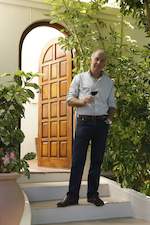Etienne le Riche feels as though he's come home to the hills and dales of Firgrove between Stellenbosch and Somerset West. It's where he and petite ballet-instructor wife Marcelle have bought a property along a quiet country lane among the vineyards, midway between mountain and sea.
Vintage 37

Called Zeezicht - the view from their sitting room takes in the distant False Bay coastline across lawn and vines - their home includes its own hectare and a half of vineyard and a small outbuilding destined for big things as the winemaking hub of Le Riche Wines.
It embodies the next exciting era of what this veteran cellarmaster has built into a fully fledged family wine business since first going solo in 1996, after having spent 20 vintages with venerable Stellenbosch wine farm, the historic Rustenberg.
Le Riche Wines was started in an old winery that had been decommissioned in the 1960s and used as a tractor and tool shed before Etienne came along 30 years later and tastefully restored it. His maiden 1996 wines were small parcels of top-quality Cabernet Sauvignon and Merlot bought in and blended and matured in a handful of small French oak barrels. Meanwhile, he set to renovating the old cellar. He gave the kuipe [open concrete red wine fermenting tanks] a fresh epoxy lining and acquired good second-hand winemaking equipment, including an old Willmes press.
His first vintage not having been vinified from scratch by Etienne himself, and hence not deemed suitable for labelling under his name by this scrupulously ethical and deeply proud man, he released as Leef op Hoop. It was the name of the Jonkershoek Valley farm owned by Kobus Marais, from whom Etienne was leasing the cellar and buying some excellent cabernet sauvignon grapes. Besides which, the moniker suited the philosophical, sometimes wry vintner's outlook on his solo winemaking venture at the time, given the meaning in translation: 'living on hope'!
Le Riche Wines was born with vintage 1997 and the Reserve Cabernet Sauvignons from that year as well as 1999 and 2000 all went on to be rated five stars in the Platter's South African Wines guide.
Grapes were sourced from specific sites around Stellenbosch renowned for great cabernet. These included Jonkershoek - the deep valley between the steep Jonkershoek and Stellenbosch mountain ranges - Firgrove (his new home) and the Muldersvlei bowl. All are vineyards with which Etienne had become well acquainted over the years, whether through winemaking or consulting for niche properties.
His portfolio grew over subsequent vintages, but he still makes wine in limited quantities only - between 4 500 and 5 000 12-bottle cases are produced under his own label. And the focus is predominantly on one variety: Cabernet Sauvignon.
Because this noble red grape has always been Etienne's strong suit and great love, he is widely regarded as the king of cabernet. 'Classic cabernets from a specialist producer' reads the concise introductory inscription to one of the Guild's auction catalogues [he is a founder member of the Guild]. 'Elegance', 'finesse', 'balance' and 'harmony' are descriptors most often used. That's Etienne and his wines in a nutshell.
His flagship is the Cabernet Sauvignon Reserve, a selection of the best vineyards in his portfolio. His Cabernet Sauvignon CWG Auction Reserve is usually from a single vineyard. The Cabernet Sauvignon is the stalwart in the stable and 'brother' to the Reserve, while the Cabernet Sauvignon Merlot is moving towards the quintessential Cape version of the traditional Bordeaux blend of red varieties, with recent vintages including Cabernet Franc and Petit Verdot.
The hectare-and-a-half vineyard next to Zeezicht is Pinotage, but he's regrafting it to Cabernet, not just because of his affinity with the variety, but because the well-drained soil, a ferricrete conglomerate colloquially known as koffi.eklip, 'is also great for Cabernet Sauvignon'.
From Vineyard to Bottle
Not that he is solely a red wine man: in 2006 he made a Chardonnay. 'At least so we could also have a white to drink to celebrate my decade of doing my own thing.' But he produces it only every second vintage, which is usually as long as the 500 cases last, being sold only to those who request it.
This is how the quiet but stubbornly independent vintner prefers doing business. He's never been one to seek fame or favour from either the public or the critics. Whatever comes his way, whether it be acclaim or loyal support from customers and clients who buy on quality rather than price, that's what he's happy to take. It's how his wines find their way to connoisseurs here and overseas.
Etienne is known as a classicist. However, he's quick to point out that being thus ‘does not mean one is old-fashioned. There's this debate about the classic versus the modern approach. What's interesting is that the youngsters are going back to traditional methods of Winemaking that I've always practised: fermenting in open-top fermenters or in barrel; trying natural yeast fermentation; manually punching down the cap rather than pumping over; and extended maceration.’
Etienne's approach to winemaking is famously pragmatic, unhurried. His wines are handcrafted, from vineyard to bottle. His long-time cellar assistant Mark Daniels spends most of the winter months personally bottling, labelling and packaging the wines, all by hand: they do about 50 cases a day.
 Beef fillet recipe with horseradish and roasted beetroot by Etienne le Riche paired with Le Riche Cabernet Sauvignon Reserve....
Beef fillet recipe with horseradish and roasted beetroot by Etienne le Riche paired with Le Riche Cabernet Sauvignon Reserve.... ‘Marcelle’s family comes from the Little Karoo and her venison pie recipe is one of my favourites.’ - Etienne le Riche....
‘Marcelle’s family comes from the Little Karoo and her venison pie recipe is one of my favourites.’ - Etienne le Riche....